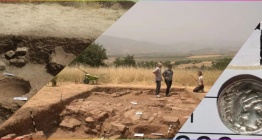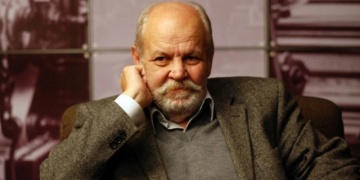The near-impossible was realized in Turkey. A very rare finding in the world of archaeology was recently discovered in two different excavation sites in Turkey. Immediately after the discovery of a skeleton with a visible brain in the Ayanis castle in Van, it was announced that a similar discovery was made in the Tavşanlı Höyük excavation in Kütahya.
Archaeologists working in Van's Ayanis Castle under the direction of Prof. Dr. Mehmet Işıklı, a faculty member at Atatürk University's Department of Archaeology, had been excavating many historical remains for 36 years, but had never found a human skeleton. This year, a skeleton was found for the first time. This was a rare skeleton in the world of archaeology. The skeleton, whose brain partially survived to the present day, excited anthropologists, and research was started to determine how old the skeleton of a young man was. A few days after this news, it was surprisingly announced that a similar discovery was made at the Tavşanlı Höyük excavation in the Tavşanlı district of Kütahya.
During the ongoing excavations led by Prof. Dr. Erkan Fidan, Head of the Department of Archaeology at Bilecik Şeyh Edebali University, Faculty of Humanities and Social Sciences, one of the skeletons belonging to two people who could not escape from their houses that were burned and destroyed during the attack on the region 3700 years ago, "brain and skin remains" preserved as carbonized (burned rapidly at very high temperatures and stuck to human bone and remained) were found.
Archaeologists were excited by the information given in the presentations made by the experts of the Tavşanlı Höyük excavation in the event, which was held for the 29th time in Belfast, the capital of Northern Ireland, on August 30-September 2 by the European Archaeological Association and is considered to be the most important archaeology meeting in the world.
A few days after this news, it was surprisingly announced that a similar discovery was made at the Tavşanlı Höyük excavation in the Tavşanlı district of Kütahya.
During the ongoing excavations led by Prof. Dr. Erkan Fidan, Head of the Department of Archaeology at Bilecik Şeyh Edebali University, Faculty of Humanities and Social Sciences, one of the skeletons belonging to two people who could not escape from their houses that were burned and destroyed during the attack on the region 3700 years ago, "brain and skin remains" preserved as carbonized (burned rapidly at very high temperatures and stuck to human bone and remained) were found.
Archaeologists were excited by the information given in the presentations made by the experts of the Tavşanlı Höyük excavation in the event, which was held for the 29th time in Belfast, the capital of Northern Ireland, on August 30-September 2 by the European Archaeological Association and is considered to be the most important archaeology meeting in the world.
 In the presentation prepared by Prof. Dr. Fidan and the vice president of the excavation, Nişantaşı University lecturer Dr. Nihan Naiboğlu, the participants were told that Tavşanlı Höyük, the oldest settlement of Kütahya with its 8 thousand years of history and one of the largest Bronze Age settlements in Western Anatolia with its 45 hectares of spread area, was probably the capital of the region, was subjected to a major attack in the 1700s BC and the entire city was burned and destroyed.
After this massive destruction, the area was left in ruins and was not inhabited for 300 years, the statement said.
The skeletons belong to two men, one young and the other middle-aged.
Scientists from many countries followed with excitement the details of the discovery of the skeletons of two people who perished under the rubble of collapsed houses.
It was also announced at the meeting that the remains of a 15-18-year-old male and a 40-45-year-old male, 130 centimeters tall, were found under the rubble of the house and pots that apparently fell from a wooden shelf in the collapsed room.
In the presentation, it was stated that the older individual could not escape somewhere in the middle of the room, that the young man was trapped under the collapsed rubble as he was about to go out the door, and that it was understood that people could not escape from the house in this building on the northeastern edge of the city, which was very vulnerable to attack, which was probably destroyed as a result of a sudden attack on the settlement.
Since all the weapons found so far in the excavations, such as daggers, spearheads, and arrowheads, came from this layer of destruction, the report stated that another great power laid siege to the city and destroyed it.
In his presentation, Prof. Dr. Yılmaz Selim Erdal, Head of the Department of Anthropology at Hacettepe University's Faculty of Letters, said that the skeletons he excavated and examined were exposed to very high temperatures and fierce fires, which is why the brain inside the skull of the young man's skeleton was preserved in carbonized form and has survived to this day.
Another striking piece of information was the discovery of carbonized pieces of the young man's skin between his chest and abdomen.
It was emphasized that there have been very few brain remains found in excavations in Anatolia so far, but the carbonized human skin is very important in terms of being "the first and only example found in archaeological periods in Turkey".
At the end of the presentation, the General Directorate of Cultural Heritage and Museums, the main sponsor of the excavation, Tavşanlı Municipality, the Turkish Historical Society, Bilecik Şeyh Edebali University Rectorate and Farika Porcelain company were thanked.
- The reasons for the attack and who carried it out are being investigated
Head of the excavation Prof. Dr. Erkan Fidan told AA (Anadolu Ajans) correspondent that with the latest finds, they determined that the entire city, which was subjected to a major attack at the end of the period they call the "Colonial Age", was burned and destroyed.
Stating that they will look for traces of the causes of this great attack and by whom it was carried out, Fidan said, "During the excavations in a building belonging to this great fire layer, we realized that dozens of terracotta pots fell into the middle of the room under the mudbrick and wooden rubble of the building. We found two human remains. The shelf in the middle of the room overturned on a man aged 40-45, while the other, a young male aged 15-18, was unfortunately trapped under the collapsed rubble two steps from the door."
Fidan said that these finds are very important scientific data for them and that the excavation and evaluation were carried out by Prof. Dr. Yılmaz Selim Erdal.
Fidan said that they identified the brain inside the skull of one of the human remains, which was preserved in carbonized form and has survived to the present day, which was apparently exposed to very high heat and severe fire, and immediately took it under protection, adding, "This is important because this is only known in 4-5 examples in Anatolia."
Informing that the skeletal remains of the young individual were found very close to the door of the building, Fidan said that he probably tried to escape but failed.
Fidan stated that the skeleton of the teenager was exposed to much higher temperatures than the other skeleton and that the bones were exposed in a whitened state due to the high temperatures, and continued his words as follows:
"However, this led to a very rare and important situation. In the part of the skeleton between the abdomen and the chest, the soft tissue, the 'human skin', was documented preserved in the carbonized form. This is a very important situation that we are not used to outside the mummification process. The example of carbonized human skin remaining on the skeleton is not known from Anatolia until today and is very important in terms of being the first example."
Prof. Dr. Fidan added that they plan to continue the excavation, which started in 2021, for at least 30 more years.
A skeleton with a visible brain was also found in Ayanis Castle, which excited anthropologists.
For 36 years, archaeologists have discovered many historical remains at the Ayanis Castle in Van, but they have never found a human skeleton. This year a skeleton was found for the first time. The skeleton, whose brain partially survived, excited anthropologists. Research is underway to determine how old the skeleton of a young man is.
In this year's phase of the excavations carried out for 36 years in Ayanis Castle, which was built by Urartu King Rusa II on the hill overlooking Lake Van, a new 4-room building group, which is thought to be connected to the temple section, and a human skeleton were unearthed for the first time.
Excavation and restoration works have been carried out for 36 years with the permission of the Ministry of Culture and Tourism in the castle, which is one of the most magnificent structures of the Urartu Kingdom with its decorations, mudbrick walls, and stone carvings that have survived for about 2,700 years in Tuşba district.
This year, a new building group with four rooms side by side was unearthed in the works carried out by a team of 20 people under the direction of Prof. Dr. Mehmet Işıklı, a faculty member of Atatürk University Department of Archaeology.
For the first time, a human skeleton with jewelry such as necklaces, bracelets, and earrings was found in the building group thought to have been used by the ruling class of the Urartians.
Thanks to the finds to be analyzed by anthropologists in the laboratory, new information about the Urartian period is expected to be obtained in the fortress.
Prof. Dr. Mehmet Işıklı: "We are having a very exciting and productive season"
Prof. Dr. Işıklı told AA correspondent that excavations have been carried out in the castle for 36 years with the support of the Ministry of Culture and Tourism.
Explaining that they expect new rooms that are the continuation of the building group to emerge at the point where excavations continue, Işıklı said, "We call this place the last magnificent castle of the Urartian Kingdom. It is one of the important fortresses in our country where excavations have been going on for a long time without interruption. We are carrying out the excavations with 20 people, including faculty members and students from different universities. We are having a very exciting and productive season. The findings and indications show that this year will be productive and enjoyable."
A new group of buildings with architectural features of the Haldi Temple site discovered
Stating that they encountered a new building group bearing the architectural features of the Haldi Temple area in the north of the castle, Işıklı said
"These northern spaces are really important. It is a very difficult area to excavate. Because we are facing a huge monumental architecture. We have reached a depth of about 6 meters. Rich groups of findings welcome us. We know there are 4 big spaces. The number may increase to 5. It is not easy to understand the function of these. There were very important findings in the first space. Last year, a bronze license plate and a unique wheeled cart were found at these points. This year, we came across a more exciting find. The prevailing opinion was that there had been an earthquake or an attack in the castle. Until today, no human remains have been found inside the castle. In terms of bones, we had not found any trace of a human being. We found the first example of this, a human skeleton in a well-preserved condition. We are talking about a young adult skeleton."
Some archaeological findings linked to the skeleton
Stating that the skeleton will be examined in the laboratory environment, Işıklı said, "We will work on the skeleton. One of the most important points is that the brain part has partially survived. The skull stands downwards. We saw the brain parts because the skull was shattered. Anthropologists are very excited. Shortly we will learn more about how and why the owner of this skeleton died. Some findings related to the skeleton have also emerged. Earrings, beads, necklaces, a group of arrowheads, and a large amount of pottery were found. The finds indicate that this area was probably used by the priests or the elite of the temple. An inscription was also uncovered. We will analyze the inscription, of which 6-7 lines are preserved. It will give us important clues."
Stating that they will reveal all the architectural features of the temple with the completion of the excavations, Işıklı noted that they will host a sky observation event shortly to contribute to the promotion of the castle.
www.arkeolojikhaber.com
copyright of photos: Anatolian Agency (AA: Aandolu Ajansı)
In the presentation prepared by Prof. Dr. Fidan and the vice president of the excavation, Nişantaşı University lecturer Dr. Nihan Naiboğlu, the participants were told that Tavşanlı Höyük, the oldest settlement of Kütahya with its 8 thousand years of history and one of the largest Bronze Age settlements in Western Anatolia with its 45 hectares of spread area, was probably the capital of the region, was subjected to a major attack in the 1700s BC and the entire city was burned and destroyed.
After this massive destruction, the area was left in ruins and was not inhabited for 300 years, the statement said.
The skeletons belong to two men, one young and the other middle-aged.
Scientists from many countries followed with excitement the details of the discovery of the skeletons of two people who perished under the rubble of collapsed houses.
It was also announced at the meeting that the remains of a 15-18-year-old male and a 40-45-year-old male, 130 centimeters tall, were found under the rubble of the house and pots that apparently fell from a wooden shelf in the collapsed room.
In the presentation, it was stated that the older individual could not escape somewhere in the middle of the room, that the young man was trapped under the collapsed rubble as he was about to go out the door, and that it was understood that people could not escape from the house in this building on the northeastern edge of the city, which was very vulnerable to attack, which was probably destroyed as a result of a sudden attack on the settlement.
Since all the weapons found so far in the excavations, such as daggers, spearheads, and arrowheads, came from this layer of destruction, the report stated that another great power laid siege to the city and destroyed it.
In his presentation, Prof. Dr. Yılmaz Selim Erdal, Head of the Department of Anthropology at Hacettepe University's Faculty of Letters, said that the skeletons he excavated and examined were exposed to very high temperatures and fierce fires, which is why the brain inside the skull of the young man's skeleton was preserved in carbonized form and has survived to this day.
Another striking piece of information was the discovery of carbonized pieces of the young man's skin between his chest and abdomen.
It was emphasized that there have been very few brain remains found in excavations in Anatolia so far, but the carbonized human skin is very important in terms of being "the first and only example found in archaeological periods in Turkey".
At the end of the presentation, the General Directorate of Cultural Heritage and Museums, the main sponsor of the excavation, Tavşanlı Municipality, the Turkish Historical Society, Bilecik Şeyh Edebali University Rectorate and Farika Porcelain company were thanked.
- The reasons for the attack and who carried it out are being investigated
Head of the excavation Prof. Dr. Erkan Fidan told AA (Anadolu Ajans) correspondent that with the latest finds, they determined that the entire city, which was subjected to a major attack at the end of the period they call the "Colonial Age", was burned and destroyed.
Stating that they will look for traces of the causes of this great attack and by whom it was carried out, Fidan said, "During the excavations in a building belonging to this great fire layer, we realized that dozens of terracotta pots fell into the middle of the room under the mudbrick and wooden rubble of the building. We found two human remains. The shelf in the middle of the room overturned on a man aged 40-45, while the other, a young male aged 15-18, was unfortunately trapped under the collapsed rubble two steps from the door."
Fidan said that these finds are very important scientific data for them and that the excavation and evaluation were carried out by Prof. Dr. Yılmaz Selim Erdal.
Fidan said that they identified the brain inside the skull of one of the human remains, which was preserved in carbonized form and has survived to the present day, which was apparently exposed to very high heat and severe fire, and immediately took it under protection, adding, "This is important because this is only known in 4-5 examples in Anatolia."
Informing that the skeletal remains of the young individual were found very close to the door of the building, Fidan said that he probably tried to escape but failed.
Fidan stated that the skeleton of the teenager was exposed to much higher temperatures than the other skeleton and that the bones were exposed in a whitened state due to the high temperatures, and continued his words as follows:
"However, this led to a very rare and important situation. In the part of the skeleton between the abdomen and the chest, the soft tissue, the 'human skin', was documented preserved in the carbonized form. This is a very important situation that we are not used to outside the mummification process. The example of carbonized human skin remaining on the skeleton is not known from Anatolia until today and is very important in terms of being the first example."
Prof. Dr. Fidan added that they plan to continue the excavation, which started in 2021, for at least 30 more years.
A skeleton with a visible brain was also found in Ayanis Castle, which excited anthropologists.
For 36 years, archaeologists have discovered many historical remains at the Ayanis Castle in Van, but they have never found a human skeleton. This year a skeleton was found for the first time. The skeleton, whose brain partially survived, excited anthropologists. Research is underway to determine how old the skeleton of a young man is.
In this year's phase of the excavations carried out for 36 years in Ayanis Castle, which was built by Urartu King Rusa II on the hill overlooking Lake Van, a new 4-room building group, which is thought to be connected to the temple section, and a human skeleton were unearthed for the first time.
Excavation and restoration works have been carried out for 36 years with the permission of the Ministry of Culture and Tourism in the castle, which is one of the most magnificent structures of the Urartu Kingdom with its decorations, mudbrick walls, and stone carvings that have survived for about 2,700 years in Tuşba district.
This year, a new building group with four rooms side by side was unearthed in the works carried out by a team of 20 people under the direction of Prof. Dr. Mehmet Işıklı, a faculty member of Atatürk University Department of Archaeology.
For the first time, a human skeleton with jewelry such as necklaces, bracelets, and earrings was found in the building group thought to have been used by the ruling class of the Urartians.
Thanks to the finds to be analyzed by anthropologists in the laboratory, new information about the Urartian period is expected to be obtained in the fortress.
Prof. Dr. Mehmet Işıklı: "We are having a very exciting and productive season"
Prof. Dr. Işıklı told AA correspondent that excavations have been carried out in the castle for 36 years with the support of the Ministry of Culture and Tourism.
Explaining that they expect new rooms that are the continuation of the building group to emerge at the point where excavations continue, Işıklı said, "We call this place the last magnificent castle of the Urartian Kingdom. It is one of the important fortresses in our country where excavations have been going on for a long time without interruption. We are carrying out the excavations with 20 people, including faculty members and students from different universities. We are having a very exciting and productive season. The findings and indications show that this year will be productive and enjoyable."
A new group of buildings with architectural features of the Haldi Temple site discovered
Stating that they encountered a new building group bearing the architectural features of the Haldi Temple area in the north of the castle, Işıklı said
"These northern spaces are really important. It is a very difficult area to excavate. Because we are facing a huge monumental architecture. We have reached a depth of about 6 meters. Rich groups of findings welcome us. We know there are 4 big spaces. The number may increase to 5. It is not easy to understand the function of these. There were very important findings in the first space. Last year, a bronze license plate and a unique wheeled cart were found at these points. This year, we came across a more exciting find. The prevailing opinion was that there had been an earthquake or an attack in the castle. Until today, no human remains have been found inside the castle. In terms of bones, we had not found any trace of a human being. We found the first example of this, a human skeleton in a well-preserved condition. We are talking about a young adult skeleton."
Some archaeological findings linked to the skeleton
Stating that the skeleton will be examined in the laboratory environment, Işıklı said, "We will work on the skeleton. One of the most important points is that the brain part has partially survived. The skull stands downwards. We saw the brain parts because the skull was shattered. Anthropologists are very excited. Shortly we will learn more about how and why the owner of this skeleton died. Some findings related to the skeleton have also emerged. Earrings, beads, necklaces, a group of arrowheads, and a large amount of pottery were found. The finds indicate that this area was probably used by the priests or the elite of the temple. An inscription was also uncovered. We will analyze the inscription, of which 6-7 lines are preserved. It will give us important clues."
Stating that they will reveal all the architectural features of the temple with the completion of the excavations, Işıklı noted that they will host a sky observation event shortly to contribute to the promotion of the castle.
www.arkeolojikhaber.com
copyright of photos: Anatolian Agency (AA: Aandolu Ajansı)







 Marmaris'te kaçak kazı yaparken yakalanan 6 defineciden 5'i tutuklandı
Marmaris'te kaçak kazı yaparken yakalanan 6 defineciden 5'i tutuklandı  Büyük İskender'in ninesinin doğduğu Lyncus Antik Kentinin bulduğu iddia edildi
Büyük İskender'in ninesinin doğduğu Lyncus Antik Kentinin bulduğu iddia edildi  Sülale boyu arkeolojiye emek veren ünlü arkeolog aileleri
Sülale boyu arkeolojiye emek veren ünlü arkeolog aileleri  Bilim tarihçisi Prof. Dr. Emre Dölen vefat etti
Bilim tarihçisi Prof. Dr. Emre Dölen vefat etti 




